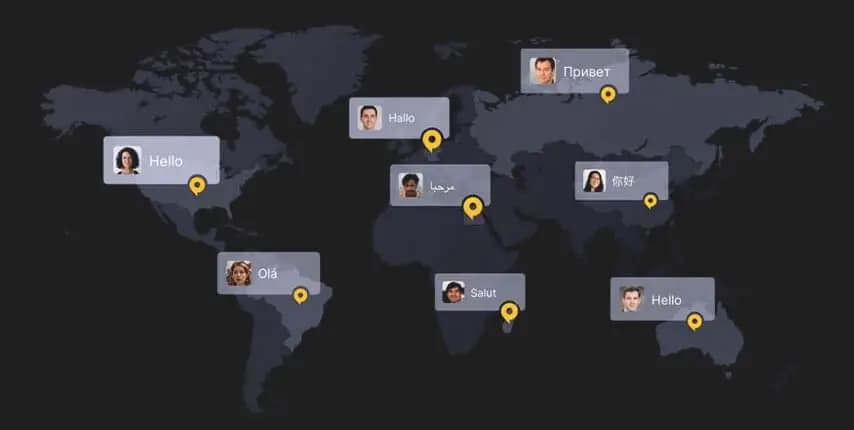How Artificial Intelligence is changing the language industry
Your Localization Roadmap
AI might have sounded like science fiction a few years ago, but it has actually been part of our world for quite a while. It dates back to 1956 when the Logic Theorist was created by John McCarthy to mimic the problem solving skills of a human.
With the advancements that have been taking place between 1956 and 2021, AI technology now works with something more complex than the machine learning technology called deep learning, which imitates the brain functionality and analyzes the situations based on the overlapping data it’s provided with. With AI algorithms becoming more sophisticated on a daily basis, it’s becoming one of the top five disruptive technologies shaping the language industry.
Wondering if this means that translation, interpreting, language instruction, culture testing and voice over talents as we know today will eventually disappear? We’ve created this guide to show you AI’s implications and we’ll leave it up to you to shape the final outcome.
Here’s how AI is taking the industry to a whole new level:
1. Neural Text to Speech
On the lines of “Internet of Things”, this AI technology is the “Internet of Voice”. This text to speech(TTS) technology, combined with a wide range of smart technologies allows the user to issue commands and get the response 100% through text. Looking for your next turn in an unfamiliar area? There’s Siri for that. Trying a new recipe and need the directions read to you while you follow the instructions? There’s Google Assistant for that. There are applications in a wide range of scenarios and have been changing the way we interact with our machines, turning our computing experience into a more human experience.
But it’s all about personalization nowadays, isn’t it? The thin line between a human experience and a personal experience is the AI powered TTS technology called neural text to speech.
So, what makes the typical text to speech, neural? It’s built with a neural network which is a type of computer network modeled on the human brain which processes data through connections between nerve cells and as these connective pathways develop through repetition, they require less effort to activate which results in learning. This is how the term “neural network” was invented, it mimics the nerve cells through artificial neurons that keep transmitting the data to the surrounding artificial neurons until the desired results are met. In this model, the data gets trained to the extent that it develops the different human emotional speaking styles and adjusts the speaking tone to match the detected mood of the speaker which brings us to real time realistic voice cloning.
2. Real Time Voice cloning
Voice cloning dates back to 1779 in Russia, when a professor built resonators that mimicked the human voice when activated by vibrating reeds in his lab in St.Petersburg. Now, with the recent advancements in technology, the computer generated audio is replacing the robotic tonality with said to be unnervingly exact and can even be tweaked to accurately portray emotions, in real time. It’s used for a myriad of industries to:
– Create indistinguishable speech from the original for game developers or film makers which gives them the ability to easily make changes after the celebrity finishes recording or even be able to finish a game or a movie with an actor who might have passed away.
-Provide interactive content for E-learning courses for the attendees to benefit as if they were in a regular classroom which reduces the operational cost of professionally recorded lectures.
-Facilitate actors’ work as brand voices by reducing the need for additional recording and raises their chances of being paid residuals.
-Foster the development of a working alliance with clients through mastering human voices to make chatbots, informative video clips, etc.
-Set the ideal tone for productions of advertisements which significantly contributes to lowering the production time and cost.
-Speeds up and eases the dubbing process by recording the voice in the language needed, then simply translates it in an automated fashion.
3. Neural Machine Translation
Instead of translating each word individually, it provides automated translation by taking into account the context in which it is used. This approach had several advantages, including: fast learning, high accuracy, scalability, customization, simple integration and flexibility.
Of course, some of the content types are best in the hands of a human translator, like the creative copy to ensure the message is conveyed accurately. But neural machine translation excels in many other scenarios:
-Online customer service: is very useful for when customer service staff members need to quickly and accurately translate requests from customers all around the world. Also, organizations that have live chats can increase their capacity while improving their customers’ experience.
-Translation of highly repetitive content: such as manuals, user guides or any other types of reference materials. The engines simply gather a huge amount of data from existing human translations of a product’s manual in different languages, and produce high-quality translations by learning.
-Translation of user-generated content (UGC) for social sentiment analysis: it offers a compelling option for brands to take advantage of the huge amount of content that people generate everyday. This enables companies to interact meaningfully with customers around the world, which is important for an effective global marketing strategy.
-Translation of large amounts of content in the shortest timeframes: for urgent matters such as natural disasters that require instant responses. For example, communicating the latest crisis developments across people at the borders.
4. AI Dubbing
Back during the good old days, classical dubbing led to a less pleasant experience for the viewer: the on-screen actor speaks while their lips move unnaturally as they pronounce words in another language, syncing would sometimes worked for some of the European languages without looking disturbing but could almost be impossible when dubbing the mouth movements in the American movies into Asian languages, every lip movement is completely out of sync. To solve that, the producers needed to adjust the localized text to suit the actor’s facial expressions, often changing the meaning of the dialog itself.
This is where AI dubbing technology comes to the rescue! The neural network within this technology learns to distinguish the characteristic features of an actor’s face, then this neural network further analyzes the same features in other people speaking different languages. So, the network simply alters the original actor’s facial traits to match the foreign dialogue flawlessly, after the foreign language dub is finished.
The Digital Future
So, is AI replacing the language industry? In fact, according to Verified Market Research, the language service industry is projected to reach USD 46.21 Billion by 2027, growing at a compound annual growth rate of 2.1% between 2021 to 2027 which according to the Bureau of Labor statistics, leads to a 24% growth rate in employment in the industry between 2021 and 2030. The language industry is simply adapting to work alongside the new technologies in order to:
-Gain a competitive edge: AI infused translation services keeps the businesses ahead of the competitors that still don’t use AI technologies. For example, deploying AI as an active listening tool to monitor calls to a customer service center like mentioned in Neural Machine Translation. The technology determines the customer points and incorporates the collected insights into the products and services. This is done instantly and detects all languages, without having to wait for an interpreter to document the comments.
-Maximize customer satisfaction: 70%+ of the online users prefer shopping from and browsing through native language websites. AI helps cater their needs without compromising on quality.
-Widen your business market: AI is allowing businesses to effectively expand their services and sales across the world as it’s given them more time to focus on their business development.
The fact that there are now websites available to translate for free might have tempted companies and individuals to try, but the results received really drove down the standards. AI is definitely irreversibly changing the industry, but still needs human efforts and intelligence to overcome many challenges such as: cultural transfer, emotions and differences in context of using certain words. For example, “desert” is a noun that refers to a dry area of land where very little rain occurs, but could refer to abandoning a person or a place. Besides these challenges, machine translation needs algorithms to carry out the required translation thus needed humans to create and implement the needed equations and algorithms.
Saudisoft is constantly working with AI’s emerging technologies, get in touch with Saudisoft’s team to know more.






